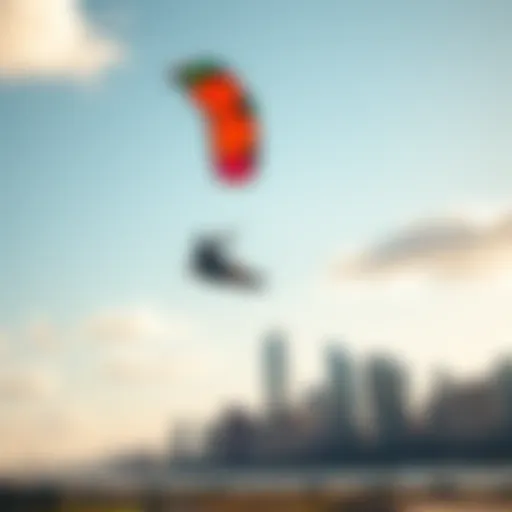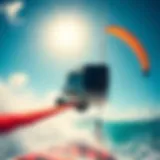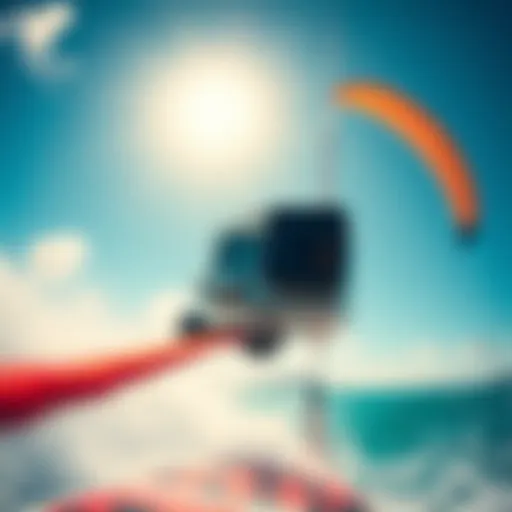Kite Surf Lessons: Essential Guide for Enthusiasts
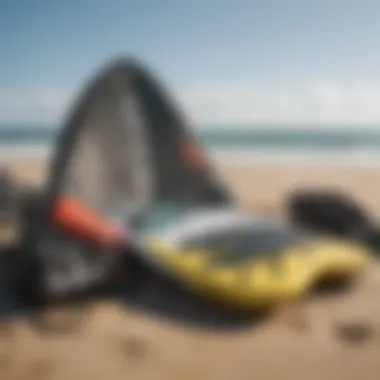

Intro
Kite surfing can feel like a dance with the wind, where every gust is a cue to engage and ride the waves. For those eager to embark on this thrilling adventure, understanding the nuances of kite surf lessons is essential. Whether you're a newcomer or someone who has been at it for a while, grasping the fundamentals can vastly enhance your experience on the water. It's not just about the sport; it's about immersing oneself in a culture that celebrates freedom, community, and adventure.
As we dive into the essentials of gear, techniques, and community in the kiteboarding world, we'll tackle the elements that shape both safety and enjoyment. Embracing the structure of a kite surf lesson not only provides valuable insights but also encourages camaraderie among enthusiasts. With this guide, we aim to equip you with vital knowledge, ensuring your journey into kite surfing is both safe and exhilarating.
Gear Insights
Having the right gear can make or break your kite surfing experience. The thrill of catching air or gliding across the water starts here, and understanding the gear options available can help you choose what’s best suited for your skill level and local conditions.
Latest Gear Reviews
The kite surfing industry is ever-evolving, with new technologies surfacing each season. Brands like Naish, Liquid Force, and Cabrinha are at the forefront, constantly innovating to provide better stability and performance. For instance:
- The Naish Pivot has gained accolades for its versatility across various wind conditions, making it ideal for both beginners and experienced riders.
- Cabrinha's Switchblade remains favored for its reliability, with smooth handling that eases learning curves.
- The Liquid Force Envy's lightweight design contributes to better control for those first attempts at kiteboarding.
Staying updated with recent reviews and user experiences can empower enthusiasts to make informed choices. Go check platforms like Reddit or dedicated kiteboarding forums for discussions on gear performance and user feedback.
Essential Gear for Beginners
The basics are crucial for starting off on the right foot. Beginners typically need the following items:
- Kite: A stable and forgiving kite that suits lighter winds, helping reduce the chance of wipeouts.
- Board: A directional board that aids in balance, providing the ability to ride comfortably across water.
- Harness: A supportive harness that properly fits to distribute the kite's pull.
- Safety Gear: Items like a helmet and impact vest can protect from falls and collisions.
- Safety Leash: This is vital to connect to your kite, ensuring it won't drift away after a crash.
- Weather Appropriate Wear: Wetsuits or drysuits to manage water temperatures.
By gathering this essential gear, beginners set the stage for a rewarding venture into kite surfing.
Techniques and Tips
Kite surfing is not just about action; it’s about refining your technique and growing your skills. Building a strong foundation in techniques will catalyze your progression in the sport.
Advanced Tricks and Techniques
Once you've mastered basic riding, you may want to branch into more advanced maneuvers. Techniques like jumping, spinning, and tricks such as the backroll or frontroll can transform your performance immensely. Here are a few tips to consider:
- Start with small jumps, practicing your timing in relation to the kite and wind.
- Gradually increase the complexity of your tricks as you grow comfortable with each.
- Video yourself while practicing; reviewing your technique can pinpoint areas to improve.
Safety Practices for Kiteboarders
Understanding safety procedures can save lives and enhance your kiteboarding experience. A few critical practices include:
- Pre-Flight Checks: Always ensure equipment is intact before hitting the water.
- Weather Awareness: Monitor wind conditions and avoid areas with potential hazards.
- Signal Protocols: Establish clear signals with fellow kiteboarders for better communication.
- Emergency Procedures: Be familiar with how to quickly release your kite in case of unforeseen circumstances.
Keeping safety at the forefront allows for a smoother, more enjoyable kite surfing experience. Even seasoned riders mustn’t let their guard down; vigilance is key.
Kiteboarding connects with the elements, allowing riders to push boundaries while fostering a culture of safety and respect within the community.
Prolusion to Kite Surfing
Kite surfing represents a blend of adventure, skill, and sheer exhilaration, drawing enthusiasts to water and wind around the globe. This article digs into the essential components that underpin kite surfing education, emphasizing the mind-boggling journey of mastering this sport. It's not just about strapping yourself onto a board and flying a kite; there's much more to it than that. This section lays the groundwork for understanding why kite surfing isn't just a hobby but an avenue for personal growth and community engagement.
The Evolution of Kiteboarding
Kiteboarding has come a long way since its inception. In the early days, people experimented with various makeshift hydrofoils and kites, often leading to awkward and clumsy experiences. Nowadays, the sport has transformed into a highly technical activity with specialized gear that allows for stunning aerial maneuvers and adrenaline-pumping speed. The innovation of materials such as ripstop nylon and advancements in harness ergonomics are just a couple of examples showing how far kiteboarding has come.
It's not just technology that's evolved. The culture surrounding kiteboarding has also blossomed, with communities forming across beaches from Tarifa to Maui. Enthusiasts no longer just ride the wind; they share tips, skills, and even local knowledge to enhance each other's experiences. The sport has seen significant cross-pollination with other water sports, integrating elements from surfing and windsurfing, creating a melting pot of techniques and styles.
Understanding the Mechanics of the Sport
To become proficient at kite surfing, grasping the mechanics is crucial. It's not merely about wielding a kite; you have to know how it interacts with wind and water. Understanding kite dynamics can be complicated, but breaking it down makes it manageable.
- Lift and Drag: The kite relies on both forces; lift helps it rise, while drag affects speed. Knowing how to manipulate these forces allows for smoother and more controlled rides.
- Wind Window: Familiarizing yourself with the wind window—the range of direction relative to your kite—is fundamental. Different parts of this window impact the timing and angle of your movements.
- Body Positioning: Positioning affects your balance and control over the board. Leaning too far back can result in a hefty wipeout, while leaning forward can help you gain traction and speed.
By comprehending the intricacies involved, you set the stage for a more enjoyable and safer experience out on the water. Mastering the mechanics turns kite surfing from a series of random attempts into a calculated sport where every movement counts, leading to personal satisfaction and improved skills.
"Foxes may trot, but the wise ones know that it's the wind in their sails that makes all the difference."
Preparing for Your First Lesson
As eager as you might feel, jumping into kite surfing without proper preparation can quickly land you in choppy waters. Grasping the significance of your first lesson is akin to laying down the foundation for a sturdy house—without this solid base, everything that follows could eventually come crashing down. It's where anticipation meets practicality and where enthusiasm finds structure.
Selecting a Reputable School
When it comes to kite surfing, finding the right school can change the game completely. Think of it as finding a good mentor; a quality instructor can impart not just skills but also a safe, enjoyable experience. Look for schools with strong reviews, experienced instructors, and well-maintained equipment. Scour local boarding communities on platforms like Reddit or Facebook. Ask around and you'll get the lay of the land.
Questions to ponder while selecting:
- What is the instructor-to-student ratio? The smaller, the better—more one-on-one time can lead to faster skill acquisition.
- What kind of insurance do they offer? It’s crucial to practice with a school that prioritizes your safety.
- Do they provide all the required gear? This helps you avoid hefty upfront costs while figuring out what suits you best.
What to Expect During Your Lesson
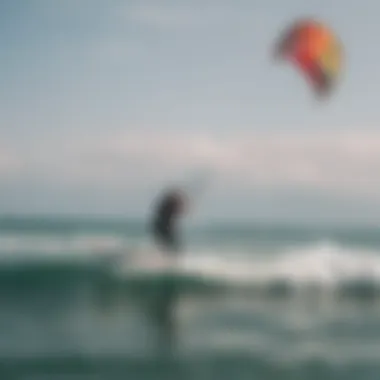

Walking onto the beach on the day of your first lesson, you might feel a mix of jitters and excitement. That's completely normal. Initially, you’ll dive into safety protocols and basic theory. Expect to learn how to launch and land the kite, an essential skill that can’t be overlooked.
Your instructor likely will start you off with a demonstration, and then you'll get hands-on experience. Keep your eyes peeled; observing your instructor can be just as valuable as the actual practice. The thrills and spills are part of progress, so don’t be afraid to laugh them off.
"The greatest mistake you can make in life is to be continually fearful you will make one." – Elbert Hubbard.
Essential Gear for Beginners
When you first step onto that sandy beach, you don’t need to come in with a full set of top-tier equipment. Stick to the essentials. Starting off right means having the proper gear that’s suited to your skill level. Here's your starter pack:
- Kite: For beginners, a smaller kite can often be easier to manage and control.
- Control Bar: This will allow you to steer with precision—think of it as the steering wheel of your kite.
- Safety Leash: A must-have to detach yourself from the kite if things get a little out of hand.
- Harness: A decent harness will save your arms, as you’ll be pulling a lot during your sessions.
- Wetsuit: Depending on where you are, a wetsuit can make your experience much more enjoyable, especially in chillier waters.
Investing in quality gear doesn’t mean burning a hole in your pocket. Many schools offer rental options, making it easier to try before you buy.
By gearing up correctly and choosing the right school, you're laying the groundwork needed for progress—and avoiding rookie mistakes. Preparing for your first lesson isn’t just about showing up; it’s about being informed and ready to embrace all kite surfing has to offer.
Skill Development Framework
The journey of mastering kiteboarding is not merely about harnessing the wind; it’s about a roadmap that leads to effective skill acquisition. The Skill Development Framework is pivotal in structuring this growth, offering multiple tiers that ensure a gradual yet steady progression.
When learners engage in kite surf lessons, they'll find that this framework provides direction and clarity. It’s akin to climbing a ladder—each rung represents a set of skills that build on the previous one, fostering confidence along the way. For beginners, having this structured approach not only aids in skill mastery but also minimizes the overwhelming nature of the sport.
Key elements include:
- Confidence Building: Structured lessons allow learners to gain confidence progressively. By mastering basics before delving into more advanced techniques, enthusiasm flourishes.
- Skill Retention: Various learning stages ensure that practices aren’t forgotten as new skills are introduced. This retention is key for building muscle memory, making skills second nature.
- Personalization: Instructors can tailor lessons within this framework to suit individual learner’s needs. This customization often results in a more fulfilling experience.
In the coming sections, we shall delve deeper into the specifics of this framework, exploring how it can effectively guide learners through their kiteboarding journey.
Progressive Learning Pathways
Establishing a progressive learning pathway is essential in kiteboarding, allowing students to evolve systematically. This involves approaching skills in stages, often beginning with the essential components of kite handling, which lays down the groundwork for all maneuvers.
Here’s how the progression often unfolds:
- Kite Control: The very first step is understanding how to pilot the kite. This doesn’t just mean flying it around but also getting a grasp on how each movement impacts the kite performance.
- Body Drag Techniques: Once comfortable with the kite, learners step into the water to practice body dragging. This teaches the connection required between the kite and the rider.
- Water Start: The pivotal moment comes when transitioning from body dragging to standing on the board. This stage is often where riders first feel the exhilaration of kiteboarding.
- Riding and Turning: Finally, riders start refining their techniques, focusing on smooth riding and mastering controlled turns.
Understanding this pathway enables learners to stay motivated, as they can see how each skill contributes to the next.
Techniques for Mastering the Basics
As with any sport, mastering the basics serves as the foundation upon which all advanced skills are built. In kiteboarding, this translates directly into learning techniques that are both fundamental and critical.
Some essential techniques include:
- Understanding Wind Dynamics: A solid grasp of wind patterns empowers a rider to handle the kite better. Knowing when and how to position the kite can make or break a session.
- Controlled Launching and Landing: These actions are crucial, as improper techniques can lead to accidents. Students learn to launch and land efficiently while maintaining safety.
- Kite Positioning: Learning how to position the kite relative to the wind—either in the power zone or out of it—for optimal control.
By leveraging focused practice on these techniques, riders can ensure their skills blossom and branch out into more sophisticated maneuvers.
Transitioning to Intermediate Skills
After mastering the basics, the real fun begins: transitioning to intermediate skills. This stage is often marked by a growth spurt in confidence as learners begin to experiment with riding styles and explore their preferences.
Key aspects to consider when making this transition include:
- Board Control: Riders start to incorporate techniques for controlling their board under more challenging conditions, including choppy water and gusty winds.
- Jumping and Tricks: Once comfortable riding, learners typically want to elevate their skills—literally! Introducing jumping and basic tricks adds another layer of excitement to the experience.
- Refining Riding Styles: Here, riders can explore different styles such as freestyle or wave riding, further diversifying their skill set. This exploration encourages personal expression through their kiteboarding journey.
Encouraging riders to step out of their comfort zone while maintaining safe practices is essential. It’s about weaving in new skills while reinforcing the foundational ones, all within a supportive learning environment.
Safety Considerations in Kite Surfing
Safety is paramount in kite surfing. The thrill of gliding across the water can quickly turn into chaos without proper precautions. Understanding the foundations of safety ensures that enthusiasts enjoy their time while minimizing risks. When kite surfing, understanding wind conditions, performing pre-lesson safety checks, and knowing emergency protocols are vital aspects that every kiteboarder should prioritize.
Understanding Wind Conditions
Wind is the lifeblood of kite surfing. Before stepping onto the water, it is essential to be aware of wind patterns and their potential changes. The ideal wind speed for beginners typically falls between 10 to 20 knots. However, it's crucial to recognize that these conditions may vary greatly. An unexpected gust or shift could create an unsafe environment.
Factors to consider include:
- Direction: Wind direction affects how the kite behaves. Offshore winds can create hazards, pushing the rider away from the shore.
- Speed: High winds can make it difficult to control the kite, raising the risk of accidents.
- Gusts and Lulls: These sudden changes in wind speed can catch even experienced riders off guard.
Understanding these aspects not only helps in selecting the right gear but also in assessing whether conditions are safe for riding.
Pre-Lesson Safety Checks
Every kite surfer, novice or experienced, should conduct a thorough safety check before hitting the waves. Here’s a simple checklist to follow prior to your lesson:
- Equipment Inspection: Examine your kite, lines, and board for any signs of wear or damage.
- Harness Check: Ensure your harness is functioning correctly and fits well to avoid unnecessary discomfort.
- Safety Systems: Test the kite's quick release and other safety features. Knowing how to activate them under duress can save your life.
- Personal Gear: Always wear a life vest, helmet, and appropriate footwear. These items provide critical protection.
- Watch the Water: Assess the water conditions, including currents and any obstacles.
Completing these checks fosters a culture of safety and ensures everyone is prepared for the adventure ahead.
Emergency Protocols
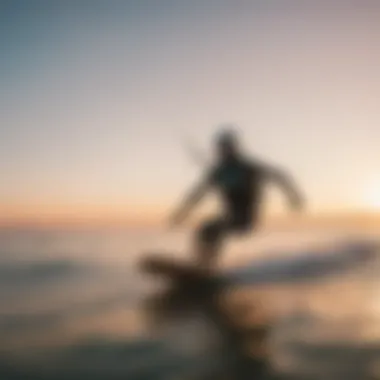

Even with all precautions taken, emergencies can occur. Knowing what to do in a crisis can make the difference. Here are key emergency protocols:
- Signal for Help: Learn the proper signals for alerting instructors or fellow kiteboarders if you're in trouble. Raising one arm above your head signaling distress is the common method.
- Self-Rescue: Familiarize yourself with self-rescue techniques. If things go wrong, it’s crucial to know how to detach your kite safely and swim back to shore.
- Keep Calm: In stressful situations, panic can lead to poor decision-making. Staying calm can help you think clearly and respond more effectively.
Ultimately, kite surfing should be an exhilarating experience, and embracing safety measures ensures a successful outing every time. Not only does it prepare you for any unforeseen circumstances, but it also protects others sharing the waters with you.
"Safety is not just a priority; it’s a lifestyle. Always be ready, so you can focus on enjoying every ride."
Environmental Influences on Kiteboarding
When it comes to kiteboarding, the environment plays a pivotal role. Understanding the environmental influences is not just beneficial; it’s essential for safety and performance. Whether you are a novice or a seasoned kiteboarder, awareness about local conditions can significantly enhance your experience on the water. Factors like beach and water conditions, as well as local regulations and etiquette, can affect how well you ride and the enjoyment you get from the sport.
Beach and Water Conditions
The first aspect to consider is the beach and water conditions. These vary greatly from one location to another and can change even within the same day. Here are some key elements to keep in mind:
- Wind Direction and Speed: Is the wind coming side-on, onshore, or offshore? Each direction affects how you launch and land your kite. For instance, onshore winds can provide a more forgiving launch site, but they can also bring waves and currents that might complicate your session.
- Wave Height: For those looking to ride waves, understanding the local swell is critical. Some beaches are known for ripping waves while others may have a more manageable chop. Choose your spot wisely based on your skill!
- Water Depth: This can be a game-changer. A shallow bottom can help beginners learn, but those with more advanced skills might crave deeper waters for tricks and maneuvers. Missing the depth can lead to unintended tumbles.
- Tides: The ebb and flow of tides also impact kiteboarding. Some areas are perfect during high tide while others come alive only when the tide is low. Knowing the tide schedule can prevent any nasty surprises.
Additionally, always keep an eye on the weather forecast. Sudden changes can lead you to rethink your plans, ensuring you stay safe.
Local Regulations and Etiquette
Kiteboarding is not just about enjoying the wind and waves; it's also about respecting the community and environment around you. Adhering to local regulations and practicing good etiquette can make your kiteboarding experience much smoother and more enjoyable.
- Access Rules: Many beaches have specific rules regarding where kiteboarding is allowed. Ignoring these could not only ruin your day but could also lead to legal trouble. Check local guidelines to ensure you’re in the clear.
- Right of Way: Knowing who has the right of way in the water can prevent accidents. Generally, the person who is downwind has the right of way. It’s a simple but vital rule that keeps everyone on the same page.
- Avoiding Crowds: If the spot is busy, be considerate. Launch your kite in a way that doesn’t create chaos. Also, practice in less crowded areas if you're still honing your skills.
- Cleanliness and Respect: Lastly, always leave the area as you found it. Dispose of any trash properly. Being tidy doesn’t just respect the nature around you; it also promotes a positive image of our sport to non-kiteboarders.
Local kiteboarding communities often thrive when participants adhere to regulations and respect shared spaces. Engaging positively contributes to the sport's growth.
By being aware of your surroundings and the local guidelines, you not only protect your own enjoyment but also that of fellow kiteboarders. Ultimately, understanding these environmental influences can ensure that every adventure on the water is both exhilarating and safe.
Gear Insights for Kite Surfing
When it comes to kite surfing, the right gear can make all the difference. Understanding how each piece of equipment influences your performance is key for both newcomers and seasoned veterans. The effectiveness, safety, and enjoyment of kiteboarding hinge on selecting the right items for your unique style and conditions. Knowing about gear isn't just for the tech-obsessed; it can elevate your experience and inform every aspect of your riding.
Kite Selection and Performance
Choosing the right kite is not just about color or brand; it's about performance and personal style. Kites come in various shapes and sizes, which affect how they handle in different conditions. For instance, delta kites offer better low-end power, making them ideal for lighter winds, while C-shaped kites provide sharper turns and higher jumps for adrenaline seekers.
Also, consider the wind window – the area in which your kite can fly. A good kite for a beginner would be versatile enough to perform well across various conditions, allowing for an easier learning curve.
Key Factors to Consider When Selecting a Kite:
- Size: Choose a kite that matches your weight and the typical wind strength in your area. Larger kites catch more wind but are harder to control, especially in strong conditions.
- Type: Decide whether you prefer a versatile all-around kite, a freestyle kite for tricks, or even a wave kite if you enjoy surf-style riding.
- Material: Quality fabric impacts durability. Look for kites made with ripstop nylon or similar materials that resist tears.
Without the right kite, every gust of wind becomes a guessing game, which is no fun at all.
Board Types and Their Functions
Just as critical as the kite is the board you ride. Boards come in several varieties, each designed for specific styles and conditions. Whether you like to carve through waves or jump over obstacles, understanding these differences helps you maximize your ride.
- Twin Tip Boards: These are the most common and are good for both beginners and experienced riders. They are symmetrical, allowing users to ride in either direction with ease.
- Directional Boards: Designed specifically for riding waves, directional boards focus more on “surfing” than jumping. These have a nose and a tail, very much like a conventional surfboard.
- Foil Boards: A newer introduction to the sport, these boards give you the ability to ride above the water. As you gain speed, a hydrofoil lifts you above the surface, providing a unique experience altogether.
Each type of board has its own characteristics and understanding these aspects can greatly impact responsiveness and stability, affecting performance on the water. Be sure to test various boards to see which one complements your style and conditions.
Harnesses: A Detailed Overview
A harness may not seem like a showstopper, but it plays an essential role in how you connect with your kite and board. A good harness keeps you secure and comfortable while allowing you to control the kite effectively.
There are two main types of harnesses:
- Seat Harnesses: Good for beginners or those who prefer a lower center of gravity. They distribute the force across the lower body, making it easier to hold the kite.
- Waist Harnesses: More popular among advanced riders as they enable more maneuverability, especially for aerial tricks. These generally sit higher on the body, giving a freer range of motion.
When choosing a harness, be sure it's the right fit. A harness that digs into your hips or feels too loose can ruin your day on the water. Look for one with good padding, adjustable straps, and a comfortable fit.
"A solid connection between your gear and your body can redefine your kite surfing experience."
The right gear for kiteboarding isn’t just a luxury; it’s fundamental for enjoying the sport and mastering the techniques involved. Take the time to educate yourself and experiment with various options until you find the perfect match.
Building a Kiteboarding Community
Creating a strong kiteboarding community is essential not just for the sport itself, but for the enjoyment and safety of every participant. Kiteboarding has a unique blend of thrill and challenge that connects individuals beyond the beach and water. When enthusiasts come together, they bring shared experiences, insights, and an unwavering support system that enhances the whole kiteboarding experience.
Importance of Connection in Sports
Connection in sports is not merely a matter of social interaction; it fosters growth, shared learning, and camaraderie. Engaging with fellow kiteboarders, whether they are experienced veterans or newcomers, can lead to numerous benefits:
- Skill Enhancement: Learning from others can significantly accelerate your own skill progression. Watching someone execute a trick can provide insights that textbooks often fail to impart.
- Safety Awareness: A tight-knit community looks out for one another. More experienced kiteboarders can share valuable safety tips and practices that might not be peripherally recognized in lessons. This culture of concern is a crucial element of our sport.
- Moral Support: Everyone has off days. A community that encourages, shares laughs, and celebrates digits of progress can make a world of difference in one's confidence and commitment.
"In the realm of sports, connection creates a bond that transcends mere competition; it is a network of shared dreams and collective triumphs."
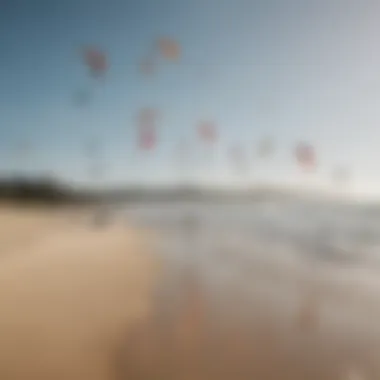

Engaging with Local Enthusiasts
Getting involved with local kiteboarders is an effective way to deepen your experience and knowledge of the sport. Local enthusiasts can become your immediate go-to source for:
- Weather and Water Conditions: Local sailors know their spots. Relying on their insights can help you make better decisions based on past experiences with wind patterns and water currents.
- Access to Equipment: Learning about local shops or rental services helps you navigate gear selection without falling prey to hype or marketing fluff. Locals will often know the best equipment for their conditions.
- Weekly Meetups: Many kiteboarding communities organize regular gatherings or events. Attending these not only builds rapport but can also introduce you to new friends that share a passion for the sport.
Sharing Experiences and Stories
Every kiteboarding journey comes with its own tales – both good and bad. Encouraging an open space to share experiences can cultivate a collective wisdom that benefits everyone. Here are a few ways to facilitate this:
- Social Media Groups: Platforms like Facebook can provide an outlet for sharing photos, tips, and personal stories. Finding a local group will keep you posted on happenings and adventures around your area.
- Kiteboarding Forums on Reddit: Online communities can be a goldmine for information. Engaging in discussions on Reddit allows you to interact with a broader audience, gain different perspectives, and learn from distant kiteboarders’ experiences.
- Attending Gatherings or Events: Participating in kiteboarding festivals or competitions not only provides opportunities for learning but also fosters friendships that can last a lifetime.
By nurturing these connections, kiteboarders can enhance their experience, ensuring that they gain the most from their time on the water. It's about so much more than just the riding; it's about the community that surrounds it.
Traveling for Kite Surfing Adventures
Exploring the globe for kite surfing presents not just an opportunity to ride the waves but also a way to immerse oneself in unique cultures and breathtaking landscapes. This part of our guide emphasizes the significance of travel in the kite surfing community. By visiting various popular locations, you gain experiences that change you forever—whether it’s hitting the peaceful shores of Tarifa, tangled with other enthusiasts, or carving through the vibrant waters off the coast of Maui.
Identifying Top Destinations
When it comes to finding the ideal place to kite surf, there are several destinations that stand out. Here are a few:
- Cabo Verde: Renowned for steady winds, this African archipelago is a paradise for both beginners and seasoned kiteboarders. The variety of spots means you'll never get bored.
- The Gold Coast, Australia: With its warm weather and vast beaches, the Gold Coast has become a kite surfer's dream, offering ideal conditions year-round.
- Hatteras, North Carolina: Known for its shallow waters and spacious beaches, Hatteras is a classic American kiteboarding destination.
- Lamu Island, Kenya: The blend of rich culture and stunning coastal views makes Lamu a bucket-list location for any kite boarder.
- The Windward Islands: Areas like St. Lucia and Barbados are tropical havens where kite surfers can enjoy both the wind and the vibe of island life.
Each of these spots offers distinct wind conditions, water types, and cultural experiences, providing a well-rounded adventure.
Preparing for a Kiteboarding Trip
Preparation is key. To ensure your kite surfing adventure goes off without a hitch, consider the following steps:
- Research the Weather: Check the seasonal wind patterns and water conditions for your destination well in advance. This helps you to avoid being caught in unfavorable weather.
- Book Accommodations Wisely: Choose a place that is not just close to kiteboarding spots but also offers easy access to local amenities. Some schools might offer package deals that combine lessons with stay.
- Pack Smart: Bring your gear if you’re comfortable traveling with it, but also check if rentals are available at your destination. Key items to pack include:
- Understand Local Rules: Each destination may have its own regulations regarding kite surfing. Familiarize yourself with these ahead of time to enjoy a hassle-free experience.
- Connect with Local Communities: Engage with local kite surfing groups through platforms like Facebook or Reddit. This can lead to insider tips for the best spots and even opportunities to join community events.
- Kite
- Board
- Harness
- Wet suit
- Sunscreen
"Traveling not only expands your horizons but also connects you with like-minded souls who share your passion. Kiteboarding across the world can be both a journey and a community experience."
Evolving Techniques and Future Trends
Kiteboarding is not just a sport; it’s a continuously evolving art form. Every year brings new innovations in gear and techniques that reshape how enthusiasts ride the waves. This section explores the significance of staying updated with these trends. Riders who stay current can maximize their performance and safety while enhancing their overall experience.
New Innovations in Equipment
The world of kite surf equipment is dynamic, characterized by cutting-edge technology and thoughtful design. Manufacturers are consistently pushing the envelope to produce gear that is lighter, stronger, and more efficient.
- Kites: Recent advancements have led to kites that feature hybrid structures, combining the benefits of different designs for improved stability and responsiveness. For instance, the latest models like the North Kiteboarding Neo integrate advanced materials to enhance durability while trimming down weight.
- Boards: The role of the board is pivotal in kite surfing, and now we see an influx of lightweight carbon boards that grip the water like never before. Duotone’s Whip is a perfect example, offering exceptional control in choppy conditions.
- Safety Gear: Many brands are also innovating safety gear. Protective harnesses that allow for greater mobility and comfort now come with integrated impact vests. An example is the Mystic Merino Impact Vest, which combines warmth with safety, ensuring riders are well protected against the unexpected.
With these innovative tools at your disposal, riders can tackle more challenging conditions, dive into new techniques, or simply enjoy the ride more fully.
Emerging Riding Styles
As kiteboarding continues to develop, it's not just the equipment that’s evolving – the way people ride is shifting dramatically as well. New riding styles reflect changes in culture, technology, and even the environments in which riders find themselves.
Types of riding styles include:
- Freestyle: This style focuses on jumps and tricks, with participants often utilizing the current innovations in kite designs to achieve spectacular aerial maneuvers. The use of a lighter kite, like the Airush Freewing, enables riders to perform complex spins and rotations.
- Wave Riding: Focusing on riding the ocean's waves, this style requires a different approach to conditions and kite control. Boards like the Fanatic Sky Air offer lightweight versatility, essential for navigating the changing dynamics of surf.
- Foilboarding: This relatively new approach allows riders to literally lift above the water, creating a unique sensation that transforms the experience. Gear tailored for this style, such as the Slingshot Foil, has revolutionized how we think about speed and efficiency on the water.
Staying informed about these emerging styles can open doors for riders of all levels, encouraging experimentation and growth within the sport. Whether you’re a weekend warrior or aspiring to become a pro, understanding the trends and innovations will help in refining your skills and enhancing your adventures.
"To ride is to evolve. Embrace change, and you'll soar."
In the ever-changing landscape of kiteboarding, staying attuned to these evolving techniques and future trends is essential. It not only empowers riders to continue their progression but also deepens the community's connection to this exhilarating sport.
End: The Path Toward Mastery
Kiteboarding is more than just an exhilarating water sport; it's an journey of growth and continuous improvement. The conclusion of our guide underscores the significance of recognizing that mastery does not come overnight. Instead, it unfolds over time through dedication, practice, and a willingness to learn from both successes and failures.
One key takeaway here is the importance of reflection on your skill progression. As you navigate the waters, take a moment to assess not just what you have achieved, but how far you've come. Along the way, there will be bumps and bruises, but they contribute to shaping you as a kiteboarder. Suppose you started your journey with a basic understanding of stance and kite control. Over time, and with careful practice, you might find yourself performing jumps or even back rolls. These milestones aren't just achievements; they serve as markers of your evolving understanding of the sport.
"The greatest teacher in life is experience, and every ride teaches us something new."
This leads us to the concept of lifelong learning. Kiteboarding, like many skills, requires you to stay engaged and curious. The moment you think you've reached the peak, there's another wave awaiting your attention. New techniques, equipment advancements, and changing environmental conditions mean there’s always something to learn. Pursuing further instruction, participating in workshops, or even just connecting with fellow enthusiasts can fuel your passion and appetite for knowledge.
Reflection on Skill Progression
Think back to your initial lessons. Do you remember your first attempt to control the kite? The initial struggle often breeds a level of determination that serves you later on. As you advance, reflecting on these experiences can enhance your understanding of your own abilities and how to approach new challenges.
- Set small benchmarks to gauge your improvement.
- Celebrate those victories, no matter how minor they may seem.
- Maintain a journal to document highs and lows; writing things down helps in processing your experiences.
By maintaining this reflective practice, you’ll not only recognize your growth but also pinpoint areas that need more focus or practice.
Encouragement for Lifelong Learning
Lifelong learning in kiteboarding offers you the chance to keep your practice fresh. It might mean experimenting with different styles, trying new tricks, or even getting certified to teach. Taking the leap to try something new, such as a different kite or board, can ignite your passion and reveal new layers to your skills. Surrounding yourself with a diverse community can also expand your horizons. Learning from someone else's experiences enhances your own.
To foster this ongoing journey, consider the following:
- Attend kiteboarding camps or events, where you can immerse yourself in skills and techniques beyond the basics.
- Join online forums like Reddit's Kiteboarding community or insights from Facebook groups dedicated to kite enthusiasts.
- Dedicate time to explore the latest innovations in gear and the evolving techniques from seasoned riders.
Thus, the path toward mastery in kiteboarding is not about reaching a ultimate destination but embracing the journey itself. Every moment spent on the water is a chance to grow, learn, and connect with the vibrant community that supports this thrilling sport.









